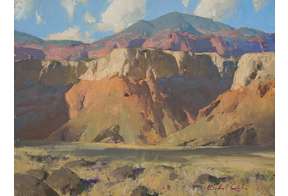Plein Air Painters of America: Out West

Couse-Sharp Historic Site is thrilled to be hosting the 2023 annual exhibition of the Plein Air Painters of America (PAPA), titled Out West. PAPA’s annual paint out and show provides an opportunity for inspired dialogue and camaraderie amongst its membership.
The genre of the American West is currently thriving, and the association’s members are excited to partake in the “Out West” theme. With breadth in style and vision, PAPA have produced a visually stunning show, illustrating the depth of inspiration the West, and Southwest, provides to so many artists.
The exhibition is in the Dean Porter Gallery of The Lunder Research Center at Couse Sharp Historic Site (CSHS) from September 29, 2023, through January 20, 2024. Admission is free, and all artwork is for sale. PAPA and CSHS are grateful for exhibition support from Western Art Collector magazine and International Artist Publishing.
Open hours are Tuesdays through Saturdays 1-5 p.m. except for the following holidays: Indigenous People's Day, Thanksgiving Day and the next day, Christmas Eve and Christmas Day, New Year's Eve, New Year's Day. Check our homepage for additional periodic closures or additional open house, such as for special events.
The artwork can also be seen on our website -- click here to view the online Exhibition Gallery.
Select PAPA members will be painting Taos Valley October 2–7, culminating in plein air demonstrations with a “wet paint” sale and exhibition on the Sharp Portal of The Lunder Research Center. The demos and sale will happen Saturday, October 7, from 12 to 5 p.m. Attendees can also partake in an open house at the historic site from 3 to 5 p.m. Click here for more information.
Exhibiting artists in PAPA: Out West are:
Douglas Andelin, Kenn Backhaus, Mitch Baird, Cindy Baron, Zufar Bikbov, Carl Bretzke, Roger Dale Brown, John Budicin, Jill Carver, Donald Demers, Kenneth DeWaard, Kathleen Dunphy, Aimee Erickson, Andy Evansen, Gay Faulkenberry, Gerald J. Fritzler, Kimball Geisler, Robert Goldman, Walt Gonske, Mike Hernandez, Jeff Horn, Kathleen Hudson, Tom Hughes, Eric Jacobsen, Jean LeGassick, John Lintott, Kyle Ma, Kevin MacPherson, Terry Miura, J. Chris Morel, James Morgan, Ned Mueller, T. M. Nicholas, Ralph Oberg, Jesse Powell, Ron Rencher, Mark Rittorno, Randall Sexton, Matt Smith, Phil Starke, John W. Taft, Bryan Mark Taylor, Linda Tippetts, Dan Young
Western artists revere the great history of Taos in art and its central place in the art market. The same qualities of light and air that attracted the early Taos school still inspires many to paint there again and again. “Taos epitomizes the vision of the Southwest for many artists, many of their heroes having worked here,” said Jill Carver, a member of the association. “Inspired by this uniquely stunning landscape, the Taos group produced some of the greatest Western imagery that exists. PAPA members come to this valley, not to follow in the footsteps of giants, but to understand the land they were inspired by, to enquire into their visual explorations, to continue that artistic dialogue with each other, and—as individual artists—to explore a conversation with that land.”
Another connection of CSHS to the plein air method is the fact that E. I. Couse and J. H. Sharp were practitioners. “Couse was primarily a studio painter, but he would head up the canyon with his favorite models Ben Lujan and Jerry Mirabal and work with them on composing narrative scenes,” noted Davison Koenig, executive director and curator at CSHS. “He’d create black-and-white photographic studies for composition and light, while also creating field sketches in oil recording the colors in nature. He would then bring his models back into the studio to paint from life using the photos and sketches as reference.”
Meanwhile, Joseph Henry Sharp was perhaps one of the most rugged plein air painters of the American West. Having built a cabin on the Crow Reservation, Sharp spent the winters of 1898–1910 painting both Crow and Blackfeet encampments and the Montana landscape. He traveled the north country in a converted sheep herders wagon that he dubbed the “Prairie Dog,” complete with a wood stove and mica skylight. “He would paint plein air in the wind and snow until his hands and his paints froze and then climb inside his wagon to thaw, then return outside to finish his work,” Koenig related. “Fortunately for our PAPA friends, they’ll be joining us at the most delightful time of the year as the autumnal splendor unfolds.”
Taos has been a “ground zero” for creatives of all sorts—visual artists, writers, entrepreneurs, and more—for generations. “Most PAPA members live and work in the West, so coming to Taos just seemed natural,” said artist Matt Smith. “A show there has been on our bucket list for years. Given its rich history in art, culture, and beauty, along with the partnership with CSHS, we agreed to not only hold our annual show Taos but our meeting and group workshop as well. We’ve pulled together to put forward our best works from across the country for this year’s event.”


